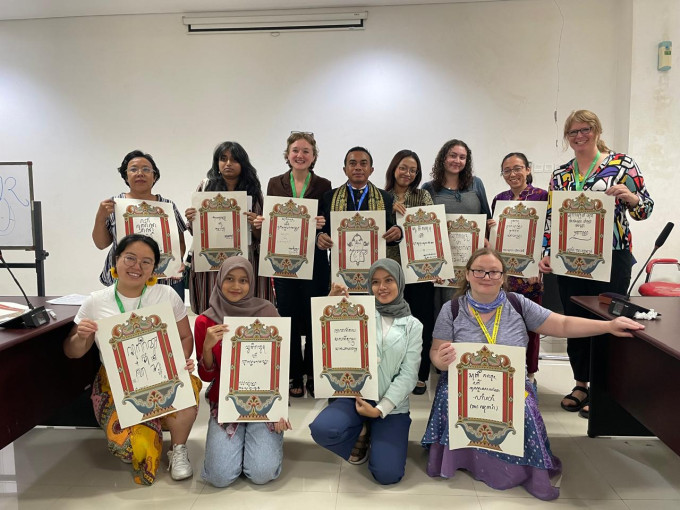
In some cultures, calligraphy is believed to be a medium that harmonizes the human soul with the universe, creating a profound experience. This experience was brought to life in the Calligraphy Workshop held on Wednesday, Jul. 10, 2024, at the UGM Faculty of Philosophy (Philosophy UGM) as part of the 2024 AAS-in-Asia Conference series.
Conference participants, including academics from different countries worldwide, had the opportunity to practice the art of Javanese, Arabic, Chinese, and Korean calligraphy in four separate classes under the guidance of skilled artists.
“It’s a delightful experience because in between academic sessions, we can also engage in such interesting activities,” said Megan, a conference participant from the UK who attended the Javanese Calligraphy training.
The workshop featured four calligraphy artists who taught the participants.
They were Kim Jang Hyun, an artist from Korea; Kashif Khan, a Sufi calligraphy artist; Wahono Simbah, a Javanese calligraphy artist; and Mansheng Wang, a Chinese painter and calligraphy artist.
Each class was attended by a dozen participants, adjusted to the room’s capacity. During the approximately 2-hour workshop, participants learned basic letters and various brushstroke techniques and created simple calligraphy on special paper provided.
Through this experience, participants also learned about the values embedded in calligraphy within each culture.
“Calligraphy is a spiritual practice that helps us build our identity. As we practice writing letter by letter, each one helps us grow from within,” said Noman Baig, a lecturer from Habib University Pakistan, a speaker in the discussion session.
According to Baig, participants are encouraged to appreciate beauty and celebrate human values through calligraphy. A similar sentiment was expressed by Mansheng Wang, who explained in his class how calligraphy can depict the beauty of nature, much like painting.
“Calligraphy and painting belong to the same family. In the past, people understood calligraphy as being like a painting, often inspired by nature,” Wang said.
Kim Jang Hyun stated that calligraphy offers the beauty of carved works and brushstrokes and conveys messages to the younger generation about the spirit of happiness and historical heritage.
Nowadays, Korean calligraphy is used in digital media communication to promote movie covers.
Wahono Simbah, a Javanese calligraphy enthusiast, explained that Javanese calligraphy always uses Javanese script, including murda, swara, and rekan characters.
Generally, Javanese calligraphy conveys messages about the relationship between the universe, God, and humans, emphasizing the importance of maintaining the balance of life.
However, in the modern era, Javanese calligraphy delivers messages of happiness, beauty, and goodness.
“It all stems from the Javanese philosophy, “Memayu Hayuning Bawono,” which reminds us always to keep the earth beautiful and sustainable. Everyone is a leader in preserving it,” Simbah said.
The calligraphy workshop titled “Of Divine Eloquence: Intertwined Conversation in The Language of Islamic, Chinese, Javanese, and Korean Calligraphies” was one of the activities at the AAS-in-Asia Conference, held from July 9-11, brought together academics from various countries who specialize in Asian studies.
In addition to the calligraphy classes, a gamelan workshop was also held earlier. These special sessions were organized to provide a unique academic experience.
Author: Gloria
Editor: Gusti Grehenson
Post-editor: Lintang

